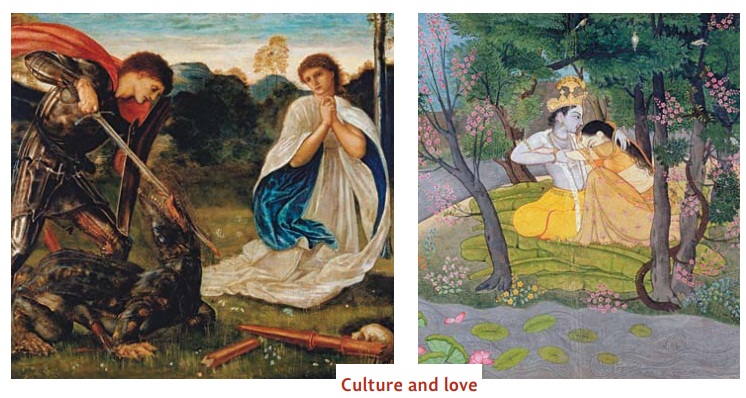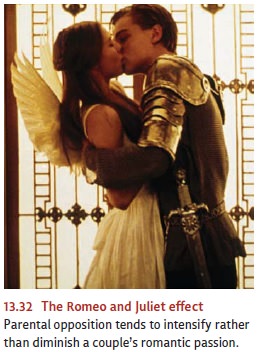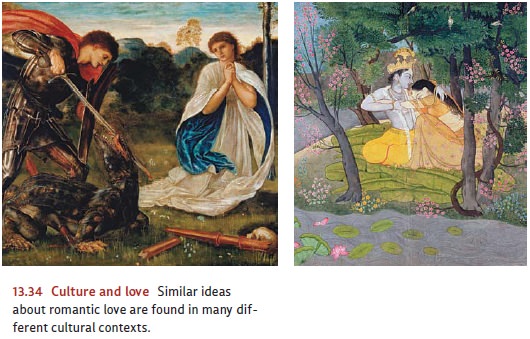Chapter: Psychology: Social Psychology
Social Relations: Love

Love
Attraction
tends to bring people closer together. If they are close enough, their
relationship may be more than friendship and become something we celebrate with
the term love. In fact, love involves
many elements: a feeling, a physiological upheaval, a desire for sexual union,
a set of living and parenting arrangements, a sharing of resources (from bank
accounts to friends), a mutual defense and caretaking pact, a merging of
extended families, and more. So complex is human love that, according to some
authorities, psychologists might have been “wise to have abdicated
responsibility for analysis of this term and left it to poets”. Wise or not,
psychol-ogists have tried to say some things about this strange state of mind
that has puzzled both sages and poets throughout the ages.
Psychologists
distinguish among different kinds of love, and some of the resulting
classification systems are rather complex. One scheme tries to analyze love
relation-ships according to the presence or absence of three main components: intimacy (feel-ings of being close), passion (sexual attraction), and commitment (a decision to stay with
one’s partner) (Sternberg, 1986, 1988). Other psychologists propose that there
are two broad categories of love. One is romantic—or passionate—love, the kind
of love that one “falls into,” that one is “in.” The other is companionate
love, a less turbulent state that emphasizes companionship, mutual trust, and
care (Hatfield, 1988).
ROMANTIC LOVE
Romantic love has been described as essentially
passionate: “a wildly emotional state[in which] tender and sexual feelings,
elation and pain, anxiety and relief, altruism and jealousy coexist in a
confusion of feelings”. Lovers feel that they are in the grip of an emotion
they cannot control, which comes across in the very language they use to
describe their love. They “fall in love,” “are swept off their feet,” and
“can’t stop themselves.” Perhaps surprisingly, men tend to fall in love more
often and more quickly than women do, and women tend to fall out of love more
easily than men do (Hill, Rubin, & Peplau, 1976).
According
to some authors, romantic love involves two distinguishable elements: a state
of physiological arousal, and a set of beliefs and attitudes that leads the
person to interpret this arousal as passion. What leads to the arousal itself ?
One obvious source is erotic excitement, but other forms of stimulation may
have the same effect. Fear, pain, and anxiety can all heighten general arousal
and so can, in fact, lend fuel to romantic passion. One demonstration comes
from a widely cited experiment in which

men
were approached by an attractive young woman who asked them to fill out a
ques-tionnaire (allegedly to help her with a class project); she then gave them
her telephone number so they could call her later if they wanted to know more
about the project. The study was conducted in Capilano Park, just north of
Vancouver, British Columbia. The park is famous for its narrow, wobbly
suspension bridge, precariously suspended over a shallow rapids 230 feet below
(Figure 13.31). Some of the men in the study were approached while they were on
the bridge itself. Others were approached after they had already crossed the
bridge and were back on solid ground.
Did
the men actually call the young woman later—ostensibly to discuss the
experiment, but really to ask her for a date? The likelihood of their making
this call depended on whether they were approached while they were on the
bridge or later, after they had crossed it. If they filled out the
questionnaire while crossing the bridge—at which point they might well have
felt some fear and excitement—the chances were almost one in three that the men
would call. If they met the young woman when they were back on safe ground, the
chances of their doing so were very much lower (Dutton & Aron, 1974; but
see also Kenrick & Cialdini, 1977; Kenrick, Cialdini, & Linder, 1979).
What is going on here? One way to think about it is to call to mind the
Schachter-Singer theory of emotion. Being on the bridge would make almost
anyone feel a little jittery—it would, in other words, cause a state of
arousal. The men who were approached while on the bridge detected this arousal,
but they seem to have misinterpreted their own feelings, attributing their elevated
heart rate and sweaty palms not to fear, but to their interest in the woman.
Then, having misread their own state, they followed through in a sensible way,
telephoning a woman whom they believed had excited them.
This
sequence of events may help us understand why romantic love seems to thrive on
obstacles. Shakespeare tells us that the “course of true love never did run
smooth,” but if it had, the resulting love probably would have been lacking in
ardor. The fervor of a wartime romance or an illicit affair is probably fed in
part by danger and frustra-tion, and many a lover’s passion becomes all the
more intense for being unrequited. All of these cases involve increased
arousal, whether through fear, frustration, or anx-iety. We interpret this arousal
as love, a cognitive appraisal that fits in perfectly with our romantic ideals,
which include both the rapture of love and the agony.

An
interesting demonstration of this phenomenon is the so-called Romeo-and-Juliet effect (named after
Shakespeare’s doomed couple, whose parents violentlyopposed their love; Figure
13.32). This term describes the fact that parental opposition tends to
intensify a couple’s romantic passion rather than to diminish it. In one study,
couples were asked whether their parents interfered with their relationship.
The greater this interference, the more deeply the couples fell in love
(Driscoll, Davis, & Lipetz, 1972). The moral is that if parents want to
break up a romance, their best bet is to ignore it. If the feuding Montagues
and Capulets had simply looked the other way, Romeo and Juliet might well have
become bored with each other by the end of the second act.
COMPANIONATE LOVE
Romantic
love tends to be a short-lived bloom. That wild and tumultuous state, with its
intense emotional ups and downs, with its obsessions, fantasies, and
idealizations, rarely, if ever, lasts forever. Eventually the adventure is
over, and romantic love ebbs. Sometimes it turns into indifference or active
dislike. Other times (and hopefully more often) it transforms into a related
but gentler state of affairs—companionate
love (Figure 13.33). This type of love is sometimes defined as the
“affection we feel for those with whom our lives are deeply intertwined”. In
companionate love, the similarity of outlook, mutual caring, and trust that
develop through day-to-day living become more important than the fantasies and
idealization of romantic love, as the two partners try to live as happily ever
after as it is possible to do in the real world. This is not to say that the
earlier passion does not flare up occa-sionally. But it no longer has the
obsessive quality that it once had, in which the lover is unable to think of
anything but the beloved (Caspi & Herbener, 1990; Hatfield, 1988; Neimeyer,
1984).

CULTURE
AND
LOVE
It
will come as no surprise that concep-tions of love are—like the many other
aspects of our interactions with others—a cultural product. Western cultural
notions of what love is and what falling in love feels like have been fashioned
by a histori-cal heritage that goes back to Greek and Roman times (with tales
of lovers hit by Cupid’s arrows), was revived during the Middle Ages (with
knights in armor slay-ing dragons to win a lady’s favor), and was finally
mass-produced by Hollywood (with a final fade-out in which the couple embraces
and lives happily ever after). This complex set of ideas about what love is,
and who is an appropriate potential love object, constitutes the context that
may lead us to interpret physiological arousal as love.

Similar
ideas about romantic love are found in many other cultures (Figure 13.34).
Hindu myths and Chinese love songs, for example, celebrate this form of love,
and, indeed, a review of the anthropological research revealed that romantic
love was pres-ent in 147 of 166 cultures (Jankowiak & Fischer, 1992). Even
so, it seems unlikely that any other culture has emphasized romantic love over
companionate love to the extent that Western culture does (e.g., De Rougemont,
1940; V. W. Grant, 1976). This is reflected in many ways, including the fact
that popular American love songs are only half as likely as popular Chinese
love songs to refer to loyalty, commitment, and endur-ing friendship, all
features of companionate love (Rothbaum & Tsang, 1998).
Why
do cultures differ in these ways? One proposal derives, again, from the
contrast between individualistic and collectivistic cultures. Collectivistic
cultures emphasize connection to one’s group, and this makes it unsurprising
that (collectivistic) China would prefer songs emphasizing loyalty—a focus on
the relationship, rather than on each individual’s feelings. To put this point
differently, romantic love often places a high premium on pursuing personal
fulfillment, even, and perhaps especially, when it con-flicts with other
duties. On this basis, members of individualistic cultures are more likely than
those in collectivistic cultures to consider romantic love important for
mar-riage. (Dion & Dion, 1996).
Related Topics